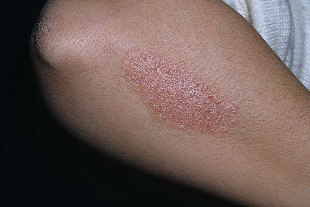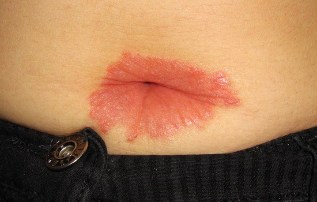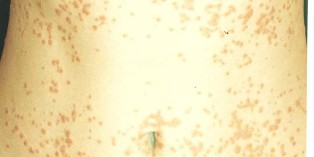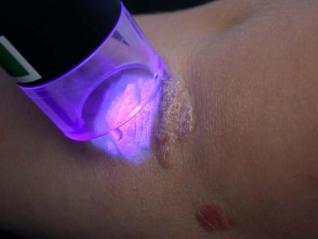Psoriasis refers to dermatoses, obviously uncomfortable rashes on the body. Almost will not suffer, but it's very itchy, look ugly, so it gives a person a lot of discomfort. Let's look at what type of psoriasis that are different to how to cure the disease .
The classification of psoriasis according to ICD-10

According to the disease international classification of psoriasis L40's code. This means that it refers to papuloscentus violations (lat. papules - "a knot" squad of "scale").
L40.0 Psoriasis vulgaris
Other names: plaque. Diagnosed almost 90% of the time. Manifested papules scaly structure. Plaque can be gray, silver-white or pinkish in color. The papules sometimes grow, connect it to the adjacent formed, the whole "Island" or "lakes".
L40.1 general acne Psoriasis
Other names: pericardial, ringworm, disease Tsumbush. Considered the most severe; manifested by blisters or blisters full of inflammatory material in the exudate. If the vial is open, inside you will get an infection, psoriasis, purulent. Most of these blisters occur the hands and feet, rarely on the body.
L40.2 Acrodermatitis, persistent
Other names: Crocker dermatitis, eczema sett horseshit. The contents of the blisters (pustules), which is a form of psoriasis, is a sterile, acrodermatitis is not an infectious disease. The main disadvantage is that the plaque in the form of the fingers, which will flake off the nails.
L40.3 Pustules of the palms, soles
Other names: pustular bactericide. In the title it is clear that this type of psoriasis affects the soles, palms. They are full of large and small nodular formations, which gradually increases, and increase in size. The contents of the gennyhólyag sterile, but pustular bactericide is considered a serious disease. The treatment is complicated by the fact that the blisters are constantly exposed to mechanical stress (wear and tear they are open, if you walk).

L40.4 Psoriasis guttate
It manifests itself as small purple dots, scattered over the thighs, shins, forearms , shoulders, head, neck, and back. Frequently develops after experiencing a strep throat or pharyngitis .
L40.5-7 Psoriasis arthropathic
Other names: arthritis, joint disorder, psoriatic arthritis. The disease affects approximately 10% of patients with psoriasis. Affect the joints and connective tissue . Externally manifested by swelling of the phalanges of the hands and feet. Rarely affects your hips, humeroscapular joints, knee joints, spine. Sometimes leading to disability: the patient can not move.
L40.8 Other psoriasis
Other names are: inverse psoriasis. It seems smooth inflamed patches, which are almost not flakes, as well as the localized in the skin folds, the folds (groin, elbow, genitals, under the Breasts, etc.). Difficulties treatment other psoriasis is associated with a constant friction on the affected areas, as well as the sweat of the skin, wrinkles. Often inverse psoriasis is caused by the fungal infection.

L40.9 Psoriasis unspecified
It includes all the other forms of psoriasis that do not fit the above.
There is another class of psoriasis the category of clinical classification.
Localization
Psoriasis plaques can spread to different body parts.
- The palm, sole. Like I said before, this is the pustular bactericide (code L40.3).
- Joints . About psoriatic arthritis speak (code L40.5-7).
- Mucous membrane. Eruptions appear in the oral cavity, conjunctiva, mucous membrane of the genital organs. Education in the form of inflammatory elements in various forms, but the boundaries. Around - a little swelling.
- Nails . Scientific name: arthritis onychodystrophy. Symptoms: indentations, furrows on the surface of the nails, the dull, the nail plate, peeling, chipping, bleed through the capillaries, itching, near the cuticle.
- Scalp. This type is called seborrheic psoriasis. Many people confuse the dandruff , because the symptoms of desquamation of the scalp. But seborrheic psoriasis is much more unpleasant disease, because the skin crack in the area of the ear, and then extend the neck. This is accompanied by strong itching, bruising, if you rip it off the wound .
- Large folds of the skin or intertrigio psoriasis. Plaques are formed between the fingers, the groin, the armpits, under the Breasts in women.
- The surface of the body. This phenomenon is called erythroderma. A variant of this disease there is a high percentage of lethal outcome because of the plaques, the skin loses essential functions: temperature control, barriers, etc.
- System level error is also dangerous, because it involves a combination of several types of psoriasis.
The clinical picture
The symptoms of psoriasis are:
- ordinary (vulgar);
- watery;
- pustular;
- arthropathic;
- in the form of erythroderma.
Erythroderma psoriatic arthritis,
The typology discussed above.
The stage of development
If we take into account psoriasis in terms of the environment , may be allocated to each of the stages.
Progressive psoriasis
The stage of maturation of the inflammation. The following properties:
- education pink smooth papules;
- itching;
- inflammatory reaction after irritation papules (scratch, trying to pierce with a needle or toothpick, etc.);
- burn the individual elements.
Inpatient psoriasis,
The stage proceeds almost without changes:
- new papules are not formed;
- old platelets do not increase the size;
- the peeling medium.
Retrogressive psoriasis

In the last stage, when the wounds are overgrown. Healing begins in the middle. The former site of formed plaques white depigmented spot that does not cause discomfort, in addition to the aesthetic component.
Seasonal exacerbation
The psoriasis is characterized by seasonal recurrence. In this regard, distinguish:
- summer psoriasis: aggravated under the action of sunlight;
- winter psoriasis due to the strong cold effect on the skin;
- off-season psoriasis: the most severe form in the absence of symptom-free periods. That is, the disease occurs throughout the year.
It looks like the manifestations of psoriasis in uniform
The affected area of the skin
This classification only 2 types of psoriasis:
- limited - less than 20% of the skin of the body;
- common - more than 20%;
- universal - struck the entire skin.
The classification of the National science Foundation (USA)
Psoriasis changes, as well as the affected area:
- easily up to 2 % of the area of the skin;
- moderate: 2-10%;
- difficult: more than 10%.
International GUY
Table for the calculation of the index lesions of psoriasis
GUY represents a number from 0 to 72 and indicates that the severe course of the psoriasis is the most mild clinical symptoms ( redness, flaking) to severe (contusions, suppuration). The index is determined by the experts.
The treatment of psoriasis
Modern strategy of treatment of the disease associated with the use of a number of methods. It is important to adhere to three main objectives:
- in order to achieve the rapid initial positive results;
- you can track the efficiency of some method or to override them, but continue to use it, that helps;
- get the sick healed.
Among the types of psoriasis treatment two:
- drug-free;
- the medicine.
The non-medicated treatment
If possible, without medication, the doctors all try to use. The treatment of psoriasis significant role to play is influenced by several factors, not medication.The mode of the day
People suffering from receiving to:
- try to quit Smoking;
- avoid alcohol (even beer);
- you wear the clothes, the linen, the natural fabric;
- change washing powder, soap ;
- short nails;
- wash only in the shower, not to visit the spa, sauna;
- try to eliminate the stress.
Diet psoriasis
The positive dynamics in the treatment of psoriasis have a good effect on a low protein diet, restricting protein to 30 grams per day. The results show a good the patients, who times a week the landing. On this day you can eat 2-3 tomatoes, a few leaves of lettuce, 1 cucumber, 2-3 cups of green tea, 300 ml of unsweetened club soda.
General principles your diet for psoriasis:
- fresh-squeezed citrus juice;
- fresh or steamed vegetables;
- fresh fish;
- flour only rye flour;
- dried fruit, fruit;
- nuts (not more than 50 g / day).
You can also limit or eliminate: meat, grain, meat, sugar, potatoes, cheese, beans, oils, sweets, coffee.
Spa treatment

Spa treatment withdrawal is not the last place in the treatment of psoriasis. This is a great anti-factor.
The psoriasis treatment the Dead sea .The main advantage of balneotherapy: the nature of the disease to combat. Water treatment, balanced nutrition, clean air, soft sun - this will help reduce the symptoms of psoriasis to go in remission.
A balneotherapy of varicose veins is a treatment garra fish rufa fish . These little creatures have no teeth, but the mouth they gently eat the particles, the scaly skin, improves the micro circulation, the skin external. In addition, the procedure gives you a great calming effect.
Physical therapy
Among the physical methods to fight the psoriasis of the skin use the following:
- ultra-violet irradiation;
- a selective light therapy ;
- laser treatment ;
- the radiation therapy;
- cryotherapy (treatment with cold);
- electro sleep;
- phonophoresis .
With the help of physical therapy you can achieve good aesthetic results, because almost every method involves the different types of effects on the skin outside. Plaques getting smaller and smaller, the formation of healthy skin cells.
Photochemotherapy
This method is selected because it is one of the most effective in the treatment of psoriasis. Used even in the severe form of the disease who do not respond well to other physiotherapy procedures. Photochemotherapy is exposure of the skin to long wave UV-a rays. Therefore, another name of the method - PUVA therapy (PUVA) .
Medication
Psoriasis treatment medication can also help relieve the main symptoms and guide the patient on the road to recovery. It is possible to divide in three stages of the general (systemic) medications for the treatment of psoriasis:
- Emergency therapy. Performed in the acute period of the disease it is designed to reduce the acute symptoms. Products used steroids, sometimes immunosuppressive .
- A transitional stage. Includes the gradual introduction of the weak-minded drug, which is in the future taken by the patient courses.
- Current maintenance therapy.
Drug therapy includes the application of topical treatments:
- creams;
- foam;
- gel;
- creams;
- ointments;
- spray.
Hormonal-based hydrocortisone ointment used for psoriasis

Medicines can be purchased or made according to the recipes of traditional medicine. The funds will remain in the open air, or airtight dressing. The maximum effect in the treatment of psoriasis a combination of drug and non-drug therapy. All means and methods selected by the doctor.
Conclusion
As you can see, the forms types of psoriasis is very much to determine what kind of disease exactly, it is very difficult. Therefore, the appearance of primary symptoms, consult your doctor, who will determine what type of psoriasis, prescribe the appropriate treatment. The earlier they start to deal with your psoriasis, more effective, fast results.























